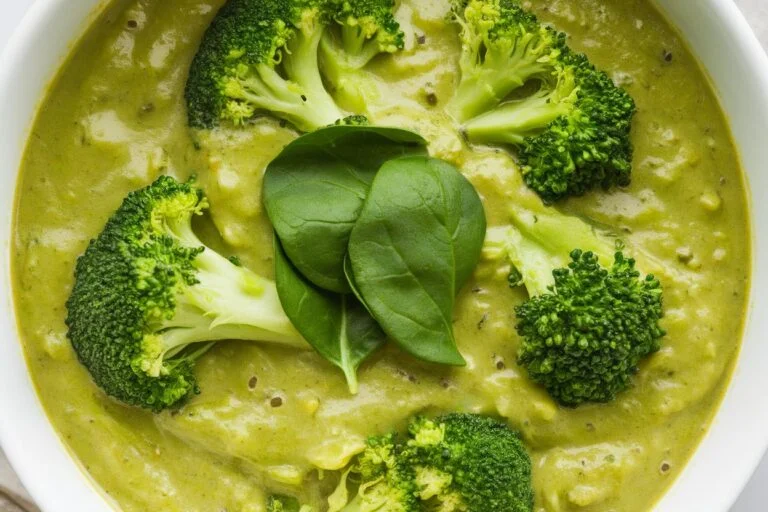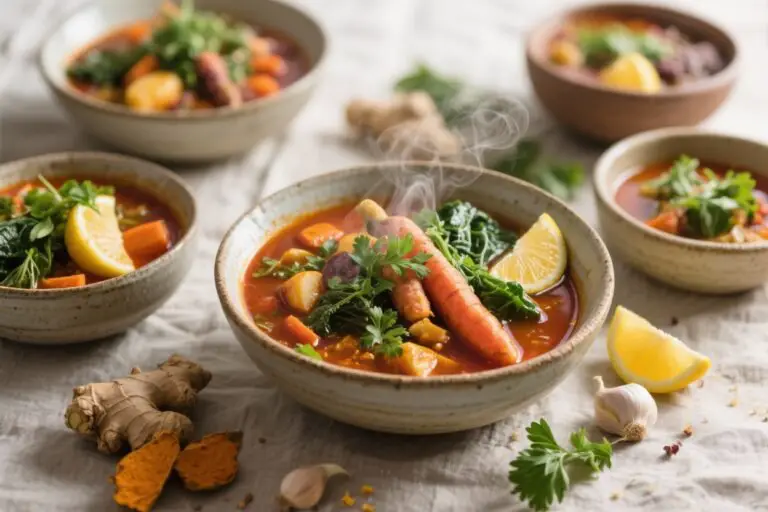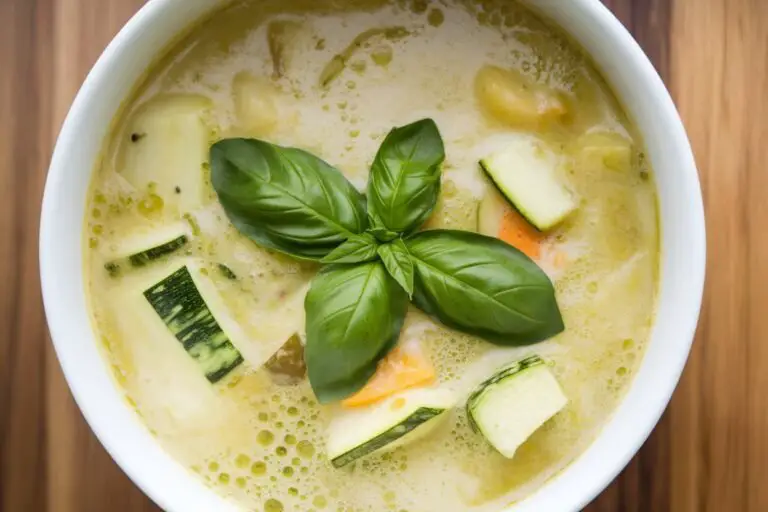Red Wine Beef Stew – A Cozy, Slow-Simmered Classic
There’s something about a pot of beef stew bubbling away that makes a house feel like home. This version leans on red wine for deep, comforting flavor and a silky sauce that clings to every bite. It’s hearty without being heavy, and it’s just as good for a weeknight as it is for a relaxed Sunday meal.
You don’t need fancy techniques, just a little patience and good ingredients. By the time it’s ready, you’ll have tender beef, sweet carrots, and a glossy sauce worth mopping up with bread.
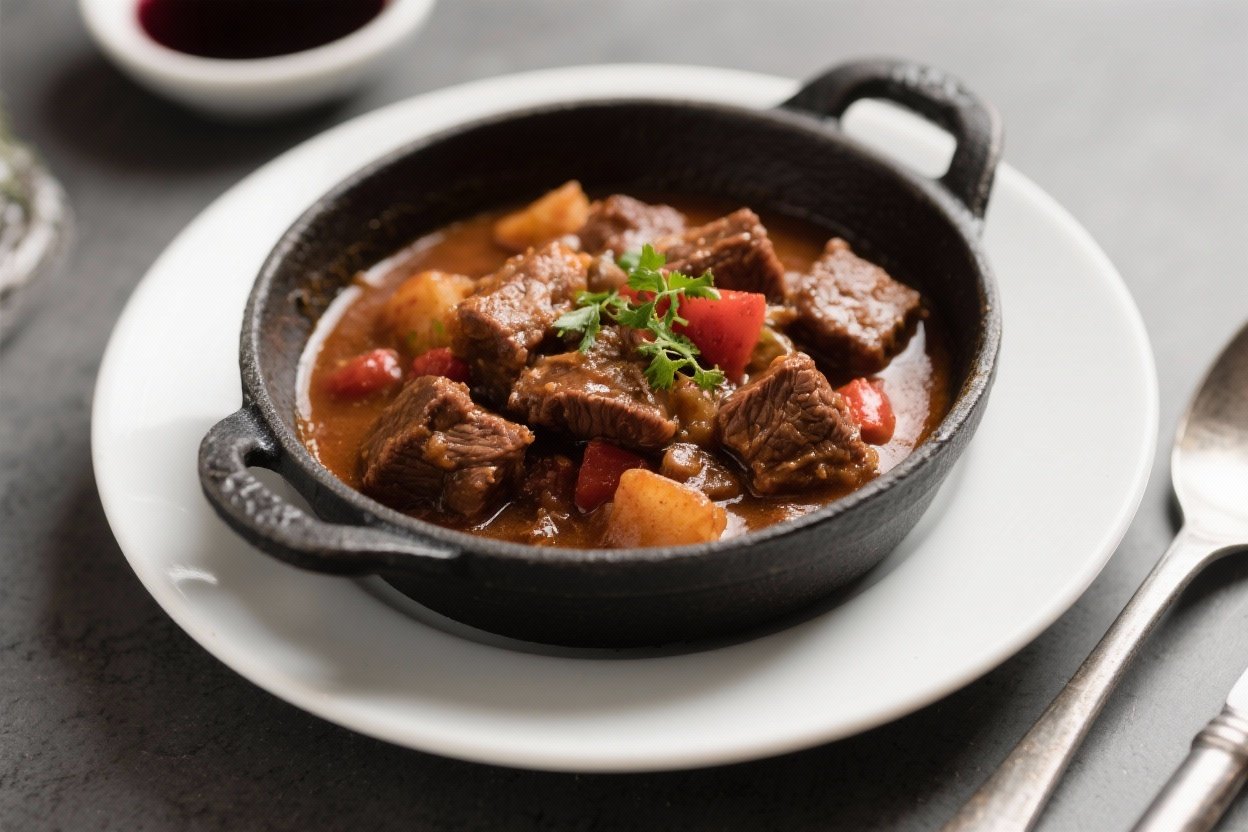
Red Wine Beef Stew - A Cozy, Slow-Simmered Classic
Ingredients
Method
- Season and dust the beef: Pat the beef dry with paper towels. Toss with salt, pepper, and flour until lightly coated. This helps with browning and thickens the stew later.
- Brown in batches: Heat 1–2 tablespoons oil in a heavy pot or Dutch oven over medium-high.Brown the beef on 2–3 sides without crowding, about 6–8 minutes per batch. Add more oil as needed. Transfer browned beef to a plate.
- Soften aromatics: Lower heat to medium.Add the onion with a pinch of salt and cook until translucent, 4–5 minutes. Stir in garlic and tomato paste and cook 1–2 minutes until the paste darkens slightly.
- Deglaze with wine: Pour in the red wine. Scrape up the browned bits from the bottom.Simmer 3–5 minutes to reduce by about a third and cook off the alcohol edge.
- Build the base: Return the beef and any juices to the pot. Add beef broth, bay leaves, and thyme. Bring to a simmer, then reduce heat to low.Cover and cook gently for 60 minutes, stirring occasionally.
- Add vegetables: Stir in carrots, potatoes, and mushrooms. Add Worcestershire sauce. Cover and simmer another 45–60 minutes, until beef is very tender and vegetables are cooked through.
- Adjust thickness: If the stew is too thin, simmer uncovered 10–15 minutes to reduce.If too thick, splash in more broth or water. Aim for a glossy, spoon-coating consistency.
- Finish and season: Remove bay leaves and thyme stems. Stir in red wine vinegar if using.Taste and adjust salt and pepper. Sprinkle with parsley before serving.
What Makes This Special
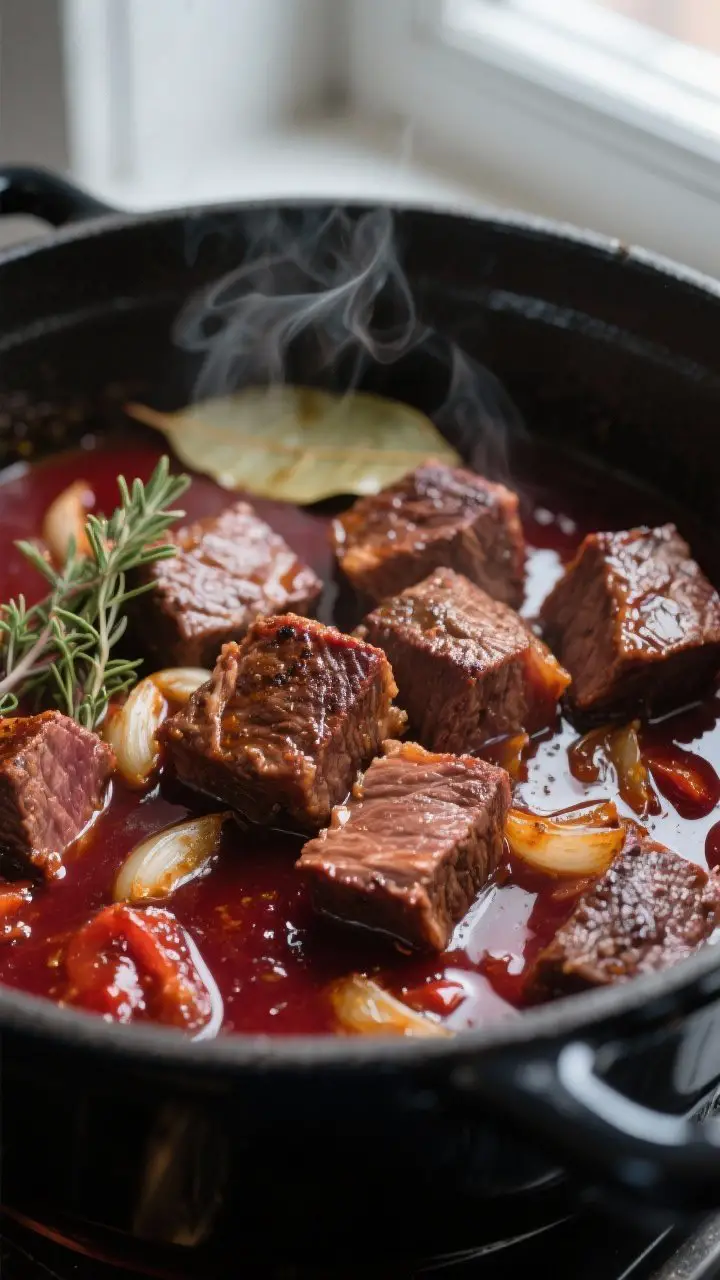
This stew builds flavor in layers. You’ll brown the beef well, sweat the aromatics, and let the red wine cook down before adding broth.
📖 Get Access to 50+ Printable Smoothie Recipes Instantly! 🖨️
Boost your health with delicious smoothies! These easy-to-follow printable recipe eBooks are perfect for detoxing, fitness goals, and tasty plant-based living. Available for instant download on Etsy! 🌿✨
That step creates a rich base that tastes like it took all day.
- Red wine reduction: Simmering the wine first removes harsh notes and concentrates flavor.
- Balanced vegetables: Carrots, onions, and mushrooms add sweetness and umami without overpowering the beef.
- Low-and-slow simmer: Gentle heat breaks down tougher cuts into melt-in-your-mouth pieces.
- Finishing touches: A splash of vinegar and fresh herbs at the end brighten the stew.
Ingredients
- 2.5 pounds beef chuck, cut into 1.5-inch cubes
- 2 teaspoons kosher salt, plus more to taste
- 1 teaspoon freshly ground black pepper
- 2 tablespoons all-purpose flour
- 2–3 tablespoons olive oil
- 1 large yellow onion, diced
- 3 cloves garlic, minced
- 2 tablespoons tomato paste
- 1 cup dry red wine (such as Cabernet Sauvignon, Merlot, or Pinot Noir)
- 3 cups beef broth (low sodium)
- 2 bay leaves
- 1 teaspoon dried thyme or 4–5 sprigs fresh thyme
- 4 medium carrots, peeled and cut into 1-inch chunks
- 1 pound baby potatoes, halved (or russets cut into large chunks)
- 8 ounces cremini or button mushrooms, halved
- 1 tablespoon Worcestershire sauce
- 1 teaspoon red wine vinegar (optional, for brightness)
- 2 tablespoons chopped fresh parsley, for serving
How to Make It

- Season and dust the beef: Pat the beef dry with paper towels. Toss with salt, pepper, and flour until lightly coated. This helps with browning and thickens the stew later.
- Brown in batches: Heat 1–2 tablespoons oil in a heavy pot or Dutch oven over medium-high.
Brown the beef on 2–3 sides without crowding, about 6–8 minutes per batch. Add more oil as needed. Transfer browned beef to a plate.
- Soften aromatics: Lower heat to medium.
Add the onion with a pinch of salt and cook until translucent, 4–5 minutes. Stir in garlic and tomato paste and cook 1–2 minutes until the paste darkens slightly.
- Deglaze with wine: Pour in the red wine. Scrape up the browned bits from the bottom.
Simmer 3–5 minutes to reduce by about a third and cook off the alcohol edge.
- Build the base: Return the beef and any juices to the pot. Add beef broth, bay leaves, and thyme. Bring to a simmer, then reduce heat to low.
Cover and cook gently for 60 minutes, stirring occasionally.
- Add vegetables: Stir in carrots, potatoes, and mushrooms. Add Worcestershire sauce. Cover and simmer another 45–60 minutes, until beef is very tender and vegetables are cooked through.
- Adjust thickness: If the stew is too thin, simmer uncovered 10–15 minutes to reduce.
If too thick, splash in more broth or water. Aim for a glossy, spoon-coating consistency.
- Finish and season: Remove bay leaves and thyme stems. Stir in red wine vinegar if using.
Taste and adjust salt and pepper. Sprinkle with parsley before serving.
Storage Instructions
- Cool first: Let the stew cool to room temperature for 30–45 minutes before storing.
- Refrigerate: Store in airtight containers for up to 4 days. The flavor deepens overnight.
- Freeze: Freeze for up to 3 months.
Leave an inch of headspace in containers for expansion.
- Reheat: Warm gently on the stove over low heat, adding a splash of water or broth to loosen. Avoid boiling to keep the beef tender.

Benefits of This Recipe
- Budget-friendly: Uses chuck, a less expensive cut that becomes tender with time.
- Make-ahead friendly: Tastes better the next day, so it’s perfect for meal prep or entertaining.
- Balanced nutrition: Protein-rich with plenty of vegetables and a reasonable amount of fat.
- Flexible: Works with different wines, vegetables, and cooking methods (stovetop, oven, slow cooker).
What Not to Do
- Don’t rush the browning: Crowding the pan leads to steaming instead of searing, which flattens flavor.
- Don’t skip the wine reduction: Adding wine straight to the broth can leave a sharp, boozy taste.
- Don’t boil vigorously: A hard boil tightens the meat. Keep it at a gentle simmer for tenderness.
- Don’t over-stir: Stirring too often breaks up vegetables and makes the stew cloudy.
- Don’t over-salt early: The stew reduces as it cooks.
Season lightly at the start and finish to taste.
Alternatives
- Wine swaps: Use a medium-bodied dry red like Merlot or Pinot Noir. If avoiding alcohol, replace wine with more broth and add 1 tablespoon balsamic vinegar for depth.
- Veggie mix-ups: Try parsnips, turnips, or celery root for earthiness. Frozen peas can be stirred in at the end for color and sweetness.
- Thickening options: Instead of flour on the beef, whisk 1 tablespoon cornstarch with 2 tablespoons water and stir in at the end, simmering until thickened.
- Herb variations: Rosemary or a bay-thyme-rosemary blend adds a woodsy note.
Finish with chives or tarragon for a lighter touch.
- Cooking methods: Oven-braise at 325°F (160°C) after step 5 for about 2.5 hours total, adding vegetables for the last hour. For a slow cooker, brown everything first, then cook on Low 7–8 hours.
FAQ
What is the best cut of beef for stew?
Beef chuck is ideal. It has enough fat and connective tissue to become tender and juicy when cooked low and slow.
Avoid very lean cuts, which can turn dry and tough.
Do I have to use an expensive wine?
No. Use a wine you’d happily drink, but it doesn’t need to be pricey. A dry, medium-bodied bottle in the $10–$15 range works well and won’t dominate the stew.
Can I make this ahead?
Absolutely.
This stew tastes even better the next day. Reheat gently and adjust the consistency with a little broth if it thickens in the fridge.
How can I make it gluten-free?
Skip the flour on the beef and thicken at the end with a cornstarch slurry (1 tablespoon cornstarch mixed with 2 tablespoons water). Check that your broth and Worcestershire sauce are gluten-free.
What should I serve with it?
Crusty bread is classic.
Mashed potatoes, buttered noodles, or creamy polenta also pair beautifully and soak up the sauce. A simple green salad adds freshness.
Why is my stew bitter?
Bitterness can come from burnt bits on the pot or from wine that wasn’t reduced. Scrape the pot well when deglazing, reduce the wine, and balance at the end with a splash of vinegar or a pinch of sugar if needed.
Can I use a pressure cooker?
Yes.
Brown the beef and aromatics on sauté, deglaze with wine, add broth and seasonings, then cook at high pressure for 35 minutes. Quick-release, add vegetables, and pressure-cook 6–8 more minutes. Finish and season as usual.
Final Thoughts
Red Wine Beef Stew is the kind of meal that rewards a little time with big, cozy flavor.
Brown the beef well, let the wine do its magic, and keep the simmer gentle. What you’ll get is tender meat, sweet vegetables, and a sauce that tastes like care. Make a big pot, share it, and enjoy the leftovers even more the next day.

